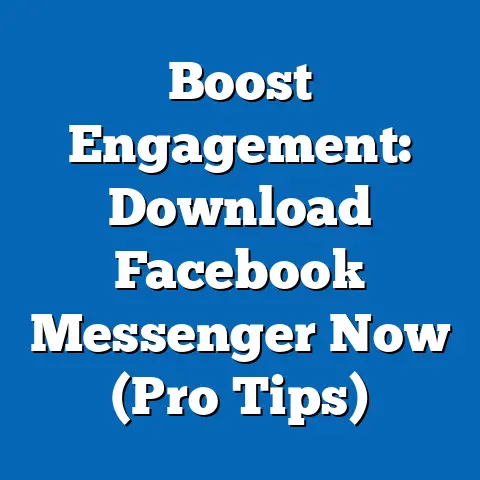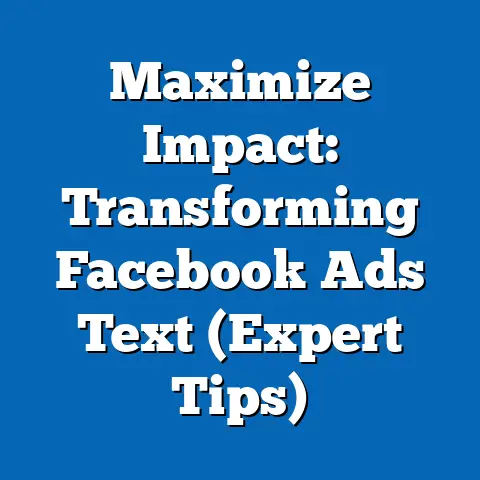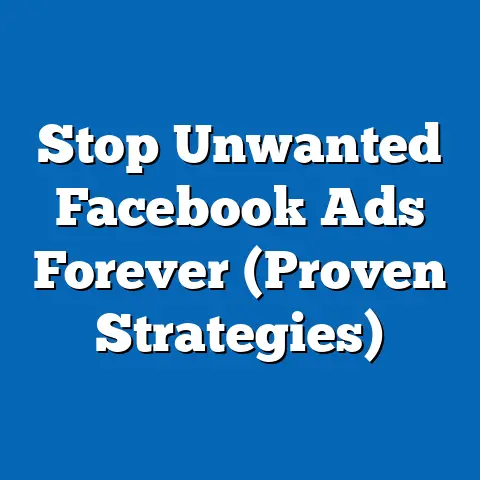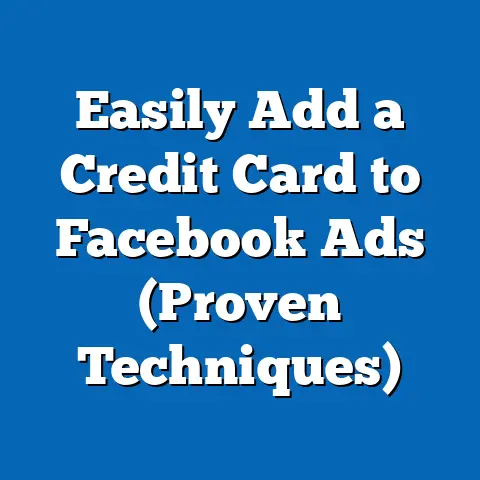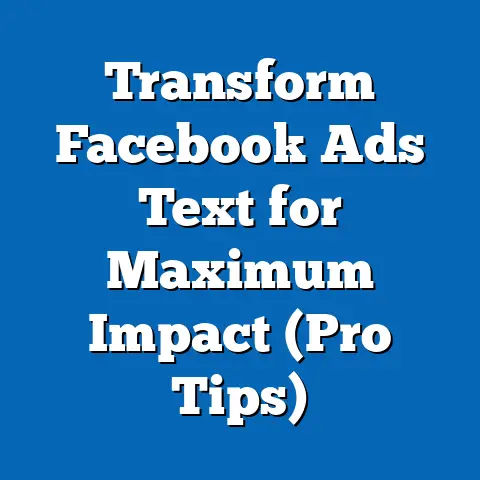Unlock Real Estate Sales with Facebook Ads (Expert Tips)
Imagine two real estate offices. In one, agents are hunched over landlines, sifting through stacks of paper, relying on outdated marketing tactics. The air is thick with frustration and the scent of stale coffee. In the other, a sleek, modern agent sits comfortably with a laptop, a calm smile playing on their lips. They’re effortlessly generating qualified leads through targeted Facebook ads, scheduling showings with ease, and closing deals faster than their analog counterparts. This isn’t a scene from a futuristic movie; it’s the reality of the real estate market today. The digital revolution is here, and Facebook ads are at the forefront, transforming how agents connect with potential buyers and sellers.
The real estate market is fiercely competitive. Standing out from the crowd requires more than just charm and local knowledge. It demands a strategic, data-driven approach that leverages the power of digital marketing. And in the realm of digital marketing for real estate, Facebook ads reign supreme. They offer an unparalleled ability to reach a vast, diverse audience with laser-like precision, delivering your message directly to those most likely to be interested in buying or selling property. I’ve seen firsthand how a well-crafted Facebook ad campaign can catapult a struggling agent to the top of their market, transforming their business and their income.
Understanding Facebook Ads
What Are Facebook Ads?
Facebook ads are paid messages that businesses create and display on the Facebook platform, including Instagram (which is owned by Meta, Facebook’s parent company). Unlike organic posts, which are only seen by your followers and their friends, Facebook ads can reach a much wider audience based on specific demographics, interests, behaviors, and locations. This makes them an incredibly powerful tool for businesses of all sizes, but especially for real estate agents looking to target potential buyers and sellers in their local market.
Think of it this way: traditional marketing methods, like newspaper ads or billboards, are like casting a wide net. You might catch a few fish, but you’re also going to catch a lot of seaweed. Facebook ads, on the other hand, are like using a fishing rod with a specific bait tailored to the fish you want to catch. You’re targeting your efforts, increasing your chances of landing a valuable lead.
There’s a wide variety of ad formats available, each with its own strengths and weaknesses. The most common include:
- Image Ads: A single image with accompanying text. Simple but effective for showcasing a property’s best features.
- Video Ads: Engaging and dynamic, perfect for virtual tours or highlighting the lifestyle a property offers.
- Carousel Ads: Allow you to display multiple images or videos in a scrolling format, ideal for showcasing different aspects of a property or multiple properties at once.
- Collection Ads: Designed for mobile devices, these ads feature a main image or video above a collection of related products, perfect for showcasing a range of properties within a specific price point or location.
- Lead Ads: Specifically designed to collect leads directly on Facebook, making it easy for potential buyers or sellers to express interest in your services.
Choosing the right ad format depends on your goals, your target audience, and the type of property you’re promoting. For example, a video ad showcasing a luxury home might be perfect for attracting high-end buyers, while a carousel ad featuring multiple starter homes could be more effective for first-time homebuyers.
The Benefits of Facebook Ads for Real Estate Agents
Why should real estate agents invest in Facebook ads when there are so many other marketing options available? The answer lies in the unique advantages that Facebook ads offer:
- Targeted Reach: This is the biggest advantage. Facebook’s sophisticated targeting options allow you to reach potential buyers and sellers based on demographics (age, gender, location), interests (real estate, home improvement, interior design), behaviors (recent home purchase, mortgage pre-approval), and even life events (marriage, new job). I once ran a campaign targeting newly engaged couples in a specific zip code, promoting a selection of starter homes perfect for young families. The results were phenomenal, generating a flood of qualified leads.
- Cost-Effectiveness: Compared to traditional advertising methods like print or television, Facebook ads are incredibly cost-effective. You can set a daily or lifetime budget that fits your needs and adjust your spending based on performance. You only pay when people see or interact with your ads, making it a much more efficient way to reach your target audience.
- Measurable Results: Facebook Ads Manager provides detailed analytics on your ad performance, allowing you to track key metrics like reach, engagement, website clicks, and lead generation. This data allows you to see what’s working and what’s not, enabling you to optimize your campaigns for maximum ROI. I remember working with an agent who was hesitant to invest in Facebook ads because they weren’t sure if it would be worth the money. After running a few campaigns and tracking the results, they were amazed by the number of leads generated and the return on their investment.
- Brand Building: Consistent and engaging Facebook ads can help you build brand awareness and establish yourself as a trusted real estate expert in your local market. Even if people aren’t immediately ready to buy or sell, seeing your ads regularly will keep you top of mind when they eventually are.
- Lead Generation: Facebook Lead Ads make it incredibly easy for potential buyers and sellers to express interest in your services. They can fill out a simple form directly on Facebook, without having to leave the platform, making the process seamless and convenient. This can significantly increase your lead generation rate.
- Scalability: You can easily scale your Facebook ad campaigns as your business grows. Whether you’re targeting a small local market or a wider regional area, Facebook ads can adapt to your needs.
According to the National Association of Realtors (NAR), 44% of homebuyers first looked online for properties. This statistic alone underscores the importance of having a strong online presence, and Facebook ads are a crucial component of that presence for real estate agents.
How Facebook Ads Work
Understanding how Facebook ads work is essential for creating effective campaigns. The process can be broken down into several key steps:
- Define Your Objectives: What do you want to achieve with your Facebook ads? Are you looking to generate leads, drive traffic to your website, increase brand awareness, or promote a specific property? Clearly defining your objectives will help you choose the right ad format, targeting options, and bidding strategy.
- Choose Your Target Audience: As mentioned earlier, Facebook’s targeting options are incredibly powerful. You can target people based on demographics, interests, behaviors, and even custom audiences (e.g., a list of your existing clients).
- Select Your Ad Placements: Choose where you want your ads to appear on Facebook and Instagram. Options include the Facebook News Feed, Instagram Feed, Facebook Marketplace, Facebook Right Column, and Instagram Stories.
- Set Your Budget and Bidding Strategy: Determine how much you’re willing to spend on your campaign and how you want to bid for ad placements. You can choose between automatic bidding (where Facebook optimizes your bids to get the most results for your budget) or manual bidding (where you set your own bids for each ad placement).
- Create Your Ad: Design your ad with compelling visuals and engaging copy that resonates with your target audience. Make sure to include a clear call to action that tells people what you want them to do (e.g., “Learn More,” “Contact Us,” “View Property”).
- Track Your Results: Use Facebook Ads Manager to monitor your ad performance and track key metrics like reach, engagement, website clicks, and lead generation. This data will help you optimize your campaigns for maximum ROI.
The Facebook advertising algorithm is constantly evolving, but the basic principles remain the same. Facebook wants to show users ads that are relevant and engaging, so the more relevant and engaging your ads are, the more likely they are to be seen by your target audience. This is why it’s so important to understand your audience, create compelling ads, and continuously optimize your campaigns based on performance data.
Takeaway: Facebook ads are a powerful tool for real estate agents, offering targeted reach, cost-effectiveness, and measurable results. Understanding the different ad formats, targeting options, and bidding strategies is essential for creating effective campaigns. Next, we’ll dive into the specifics of setting up your Facebook ads for real estate.
Setting Up Your Facebook Ads for Real Estate
Creating a Business Account
Before you can start running Facebook ads, you need to set up a Facebook Business Manager account. This is a separate account from your personal Facebook profile and allows you to manage your business pages, ad accounts, and other assets in one place. Don’t worry, it’s a straightforward process.
Here’s a step-by-step guide:
- Go to business.facebook.com and click “Create Account.”
- Enter your business name, your name, and your business email address.
- Follow the prompts to provide more information about your business.
- Once your account is created, you’ll need to add your Facebook Page to it. If you don’t already have a Facebook Page for your real estate business, you’ll need to create one.
- To add your Page, go to “Business Settings” and click “Pages.”
- Click “Add” and choose “Add a Page.”
- Enter the name of your Page and select it from the list.
- Next, you’ll need to create an ad account. This is where you’ll manage your Facebook ad campaigns.
- To create an ad account, go to “Business Settings” and click “Ad Accounts.”
- Click “Add” and choose “Create a New Ad Account.”
- Enter your ad account name, time zone, and currency.
- Choose who will be managing the ad account (you) and assign yourself the necessary permissions.
- Finally, you’ll need to add your payment information to your ad account. This is how you’ll pay for your Facebook ads.
- Go to “Business Settings” and click “Payment Settings.”
- Click “Add Payment Method” and enter your credit card or PayPal information.
Once you’ve completed these steps, you’re ready to start creating your Facebook ad campaigns. I know it seems like a lot, but trust me, once you’ve done it once, it becomes second nature.
Identifying Your Target Audience
This is arguably the most crucial step in creating effective Facebook ads. You can have the most beautiful property and the most compelling ad copy, but if you’re showing it to the wrong people, you’re wasting your time and money. Think of it like this: you wouldn’t try to sell a beachfront condo to someone who lives in the mountains and hates the ocean, would you?
Facebook offers a wealth of targeting options to help you reach the right audience:
- Demographic Targeting: Target people based on age, gender, location, education, relationship status, and job title. For example, you could target first-time homebuyers in a specific city who are between the ages of 25 and 35.
- Interest-Based Targeting: Target people based on their interests, hobbies, and the Pages they like on Facebook. For example, you could target people who are interested in real estate, home improvement, interior design, or gardening.
- Behavioral Targeting: Target people based on their online behavior, such as their purchase history, travel habits, and device usage. For example, you could target people who have recently visited real estate websites or who have been pre-approved for a mortgage.
- Custom Audiences: Create custom audiences based on your existing customer data, such as your email list or website visitors. This allows you to retarget people who have already shown interest in your services. I’ve had great success uploading my email list of past clients and targeting them with ads promoting new listings or market updates.
- Lookalike Audiences: Create lookalike audiences based on your custom audiences. This allows you to reach new people who share similar characteristics and interests with your existing customers. This is a fantastic way to expand your reach and find new potential leads.
To effectively identify your target audience, consider the following questions:
- Who is your ideal buyer? What are their demographics, interests, and behaviors?
- What type of property are you selling? Is it a starter home, a luxury home, or a retirement home?
- Where are they located? Are they local to your area or are they relocating from another city or state?
- What are their pain points and motivations? What are they looking for in a property and what are their biggest concerns?
By answering these questions, you can create a detailed profile of your target audience and use Facebook’s targeting options to reach them with your ads.
Crafting Compelling Ad Copy
Your ad copy is what will ultimately convince people to click on your ad and learn more about your property or services. It needs to be clear, concise, and compelling. Here are some tips for writing effective ad copy:
- Start with a Hook: Grab people’s attention with a catchy headline or opening sentence. Use strong verbs and emotional language to create a sense of urgency or excitement. For example, “Dream Home Alert! Stunning 3-Bedroom Home in Prime Location” or “Stop Renting, Start Owning! Affordable Homes Available Now.”
- Highlight Key Features: Focus on the most appealing features of the property, such as its location, size, amenities, or unique selling points. Use descriptive language to paint a picture in the reader’s mind. For example, “Enjoy breathtaking views from your private balcony” or “Relax in your spacious backyard with a sparkling pool.”
- Address Pain Points: Acknowledge the challenges that potential buyers face and offer solutions. For example, “Tired of cramped apartments? Discover spacious homes with room to grow” or “Worried about rising interest rates? We can help you find the best financing options.”
- Include a Clear Call to Action: Tell people what you want them to do. Use strong action verbs like “Learn More,” “Contact Us,” “View Property,” or “Schedule a Showing.” Make it easy for them to take the next step.
- Keep it Concise: People have short attention spans, so keep your ad copy brief and to the point. Focus on the most important information and avoid unnecessary jargon.
- Use Emojis: Emojis can add a touch of personality to your ad copy and help it stand out in the News Feed. Use them sparingly and make sure they’re relevant to your message.
I’ve found that using a conversational tone in my ad copy can be very effective. People are more likely to respond to ads that feel authentic and genuine, rather than salesy and pushy.
Choosing the Right Visuals
Visuals are just as important as your ad copy. In fact, they’re often the first thing people see, so they need to be eye-catching and engaging. Here are some tips for choosing the right visuals for your real estate ads:
- Use High-Quality Images: Invest in professional photography or videography to showcase your properties in their best light. Avoid blurry or poorly lit images.
- Showcase the Best Features: Focus on the most appealing aspects of the property, such as its curb appeal, interior design, or outdoor space.
- Consider a Virtual Tour: Virtual tours are a great way to give potential buyers a realistic sense of the property without having to physically visit it.
- Use Drone Footage: Drone footage can provide stunning aerial views of the property and its surroundings.
- Tell a Story: Use your visuals to tell a story about the property and the lifestyle it offers. For example, you could show a family enjoying a barbecue in the backyard or a couple relaxing by the pool.
- Brand Your Visuals: Include your logo or brand colors in your visuals to increase brand recognition.
I always recommend using a variety of visuals in your ad campaigns to see what resonates best with your target audience. A/B testing different images and videos can help you identify the most effective visuals for your ads.
Takeaway: Setting up your Facebook ads for real estate requires creating a Business Manager account, identifying your target audience, crafting compelling ad copy, and choosing the right visuals. By following these steps, you can create effective campaigns that generate leads and drive sales. Next, we’ll explore how to design effective real estate ads.
Designing Effective Real Estate Ads
Ad Formats and Their Uses
We touched on ad formats earlier, but let’s delve deeper into how to strategically use each one for real estate:
- Single Image Ads: The workhorse of Facebook advertising. They’re simple to create and can be highly effective if you use a stunning, high-quality photo of the property.
- Use Case: Showcasing a property with excellent curb appeal or a particularly impressive interior feature.
- Tip: Use a clear, concise headline that highlights the key selling point of the property.
- Single Video Ads: Video is king! It’s more engaging than static images and allows you to showcase the property in a dynamic and immersive way.
- Use Case: Virtual tours, highlighting the lifestyle a property offers, or showcasing the surrounding neighborhood.
- Tip: Keep your videos short and sweet (under 60 seconds) and include captions for viewers who watch with the sound off.
- Carousel Ads: Perfect for showcasing multiple properties or different aspects of a single property.
- Use Case: Showcasing a range of properties within a specific price point or location, or highlighting different rooms in a single property.
- Tip: Use compelling visuals and concise descriptions for each card in the carousel.
- Collection Ads: Designed for mobile devices, these ads feature a main image or video above a collection of related products.
- Use Case: Showcasing a collection of properties that fit a specific buyer profile, such as first-time homebuyers or luxury buyers.
- Tip: Use high-quality visuals and create a seamless mobile shopping experience.
- Lead Ads: These ads are specifically designed to collect leads directly on Facebook.
- Use Case: Generating leads for open houses, property tours, or consultations.
- Tip: Keep your lead form short and simple, asking only for the most essential information.
- Use Case: Showcasing a property with excellent curb appeal or a particularly impressive interior feature.
- Tip: Use a clear, concise headline that highlights the key selling point of the property.
- Use Case: Virtual tours, highlighting the lifestyle a property offers, or showcasing the surrounding neighborhood.
- Tip: Keep your videos short and sweet (under 60 seconds) and include captions for viewers who watch with the sound off.
- Use Case: Showcasing a range of properties within a specific price point or location, or highlighting different rooms in a single property.
- Tip: Use compelling visuals and concise descriptions for each card in the carousel.
- Use Case: Showcasing a collection of properties that fit a specific buyer profile, such as first-time homebuyers or luxury buyers.
- Tip: Use high-quality visuals and create a seamless mobile shopping experience.
- Use Case: Generating leads for open houses, property tours, or consultations.
- Tip: Keep your lead form short and simple, asking only for the most essential information.
I once ran a campaign using carousel ads to showcase a selection of properties in a new development. Each card in the carousel featured a different property, along with a brief description and a call to action to “Learn More.” The campaign generated a significant number of leads and helped to drive sales in the development.
A/B Testing Your Ads
A/B testing, also known as split testing, is the process of comparing two versions of an ad to see which one performs better. It’s a crucial part of optimizing your Facebook ad campaigns and ensuring you’re getting the most bang for your buck.
Here are some elements you can test in your Facebook ads:
- Headlines: Test different headlines to see which ones grab people’s attention and generate the most clicks.
- Images/Videos: Test different visuals to see which ones resonate best with your target audience.
- Ad Copy: Test different ad copy to see which ones are most persuasive and compelling.
- Call to Action Buttons: Test different call to action buttons to see which ones generate the most conversions.
- Targeting Options: Test different targeting options to see which ones reach the most qualified leads.
- Ad Placements: Test different ad placements to see which ones deliver the best results.
To conduct an A/B test, create two versions of your ad with only one element different between them. For example, you could create two versions of an ad with different headlines, but everything else remains the same. Run both ads simultaneously and track their performance to see which one performs better.
Facebook Ads Manager makes it easy to set up and run A/B tests. Simply create a new campaign and choose the “A/B Test” objective. Follow the prompts to create your two ad variations and set your budget and schedule.
I recommend running A/B tests on a regular basis to continuously optimize your Facebook ad campaigns. Even small changes can have a significant impact on your results.
Budgeting Your Campaign
Setting a budget for your Facebook ad campaign can be tricky. You want to spend enough to reach your target audience and generate leads, but you don’t want to overspend and waste money.
Here are some factors to consider when setting your budget:
- Your Goals: What are you trying to achieve with your campaign? Are you looking to generate leads, drive traffic to your website, or increase brand awareness? The more ambitious your goals, the larger your budget will need to be.
- Your Target Audience: How large is your target audience? The larger your target audience, the more you’ll need to spend to reach them.
- Your Competition: How competitive is the real estate market in your area? If there are a lot of other agents running Facebook ads, you’ll need to spend more to stand out from the crowd.
- Your Ad Quality: How relevant and engaging are your ads? The higher the quality of your ads, the lower your cost per click (CPC) and cost per impression (CPM) will be.
You can choose between a daily budget or a lifetime budget. A daily budget allows you to spend a certain amount of money each day, while a lifetime budget allows you to spend a certain amount of money over the entire duration of the campaign.
Understanding CPC and CPM is also crucial for budgeting:
- CPC (Cost Per Click): The amount you pay each time someone clicks on your ad.
- CPM (Cost Per Mille): The amount you pay for every 1,000 impressions of your ad.
The average CPC and CPM for real estate ads vary depending on the location, target audience, and ad quality. However, you can expect to pay anywhere from \$0.50 to \$5.00 per click and \$5 to \$20 per 1,000 impressions.
I recommend starting with a small budget and gradually increasing it as you see results. Monitor your ad performance closely and adjust your budget accordingly. Don’t be afraid to experiment and try different bidding strategies to see what works best for you.
Takeaway: Designing effective real estate ads involves choosing the right ad formats, A/B testing your ads, and setting a budget that aligns with your goals and target audience. By following these tips, you can create high-performing campaigns that generate leads and drive sales. Next, we’ll discuss how to track and analyze your Facebook ad performance.
Tracking and Analyzing Your Facebook Ad Performance
Understanding Facebook Ads Manager
Facebook Ads Manager is your central hub for creating, managing, and analyzing your Facebook ad campaigns. It’s a powerful tool that provides a wealth of data and insights to help you optimize your ads for maximum ROI.
Here’s a brief overview of the key features of Facebook Ads Manager:
- Campaigns: Where you create and manage your ad campaigns.
- Ad Sets: Where you define your target audience, set your budget, and choose your ad placements.
- Ads: Where you create your individual ads with compelling visuals and engaging copy.
- Reporting: Where you track your ad performance and analyze key metrics.
- Audience Insights: Where you learn more about your target audience and discover new targeting opportunities.
To access Facebook Ads Manager, simply go to business.facebook.com and click on “Ads Manager.” You’ll be presented with a dashboard that provides an overview of your ad performance.
I recommend spending some time familiarizing yourself with the different features of Facebook Ads Manager. The more you understand how to use the tool, the better equipped you’ll be to create and manage effective ad campaigns.
Key Metrics to Track
Tracking the right metrics is essential for understanding the performance of your Facebook ad campaigns and making data-driven adjustments. Here are some of the most important metrics to track:
- Reach: The number of people who saw your ad. This metric tells you how wide of an audience you’re reaching.
- Impressions: The number of times your ad was displayed. This metric tells you how frequently your ad is being shown to people.
- Clicks: The number of times people clicked on your ad. This metric indicates how engaging your ad is and how interested people are in learning more.
- Click-Through Rate (CTR): The percentage of people who saw your ad and clicked on it. This metric is a good indicator of the relevance and effectiveness of your ad.
- Cost Per Click (CPC): The amount you pay each time someone clicks on your ad. This metric tells you how efficiently you’re spending your budget.
- Conversions: The number of people who took a desired action after clicking on your ad, such as filling out a lead form, visiting your website, or scheduling a showing. This metric is the ultimate measure of your ad’s success.
- Conversion Rate: The percentage of people who clicked on your ad and completed a desired action. This metric tells you how effectively your ad is converting clicks into leads or sales.
- Return on Ad Spend (ROAS): The amount of revenue you generate for every dollar you spend on advertising. This metric is a key indicator of the profitability of your ad campaigns.
It’s important to track these metrics over time to identify trends and patterns. Are your click-through rates declining? Are your conversion rates improving? By monitoring your ad performance closely, you can identify areas for improvement and optimize your campaigns for maximum ROI.
I always create a custom dashboard in Facebook Ads Manager to track the metrics that are most important to me. This allows me to quickly and easily see how my campaigns are performing at a glance.
Making Data-Driven Adjustments
The data you collect from Facebook Ads Manager is only valuable if you use it to make informed decisions and optimize your campaigns. Here are some examples of how you can use data to improve your ad performance:
- If your click-through rates are low: Try testing different headlines, images, or ad copy to see if you can improve the relevance and engagement of your ads.
- If your cost per click is high: Try refining your targeting options to reach a more qualified audience. You could also try experimenting with different bidding strategies to see if you can lower your costs.
- If your conversion rates are low: Make sure your landing page is optimized for conversions. Is it easy for people to fill out a lead form or schedule a showing? Are you providing them with the information they need to make a decision?
- If your return on ad spend is low: Evaluate your entire campaign to identify areas for improvement. Are you targeting the right audience? Are you using the right ad formats? Are you tracking the right metrics?
Don’t be afraid to experiment and try new things. The key is to continuously monitor your ad performance and make data-driven adjustments to optimize your campaigns for maximum ROI.
I once worked with an agent who was struggling to generate leads from their Facebook ad campaigns. After analyzing their data, I discovered that they were targeting a very broad audience with generic ad copy. I recommended that they refine their targeting options to reach a more specific audience and create more compelling ad copy that addressed their pain points. Within a few weeks, their lead generation rate had increased significantly.
Takeaway: Tracking and analyzing your Facebook ad performance is crucial for optimizing your campaigns and maximizing your ROI. By understanding Facebook Ads Manager, tracking key metrics, and making data-driven adjustments, you can create high-performing campaigns that generate leads and drive sales. Next, we’ll explore some advanced strategies for real estate Facebook ads.
Advanced Strategies for Real Estate Facebook Ads
Retargeting Strategies
Retargeting is a powerful technique that allows you to show ads to people who have already interacted with your business, such as visiting your website, viewing a property listing, or engaging with your Facebook Page. It’s a highly effective way to re-engage potential clients who have shown interest in your services and guide them further down the sales funnel.
Think of it this way: someone who has visited your website is already more interested in your services than someone who has never heard of you. Retargeting allows you to capitalize on that existing interest and increase your chances of converting them into a lead or sale.
Here are some retargeting strategies you can use for real estate Facebook ads:
- Website Visitors: Show ads to people who have visited your website but haven’t yet filled out a lead form or scheduled a showing. You can create a custom audience in Facebook Ads Manager based on website traffic.
- Property Viewers: Show ads to people who have viewed specific property listings on your website. This allows you to re-engage them with the properties they were interested in and encourage them to take the next step.
- Facebook Page Engagers: Show ads to people who have liked or followed your Facebook Page, or who have engaged with your posts or ads. This allows you to stay top of mind with your existing fans and followers.
- Lead Form Abandoners: Show ads to people who started filling out a lead form but didn’t complete it. This allows you to remind them to finish the form and capture their contact information.
To implement retargeting, you’ll need to install the Facebook Pixel on your website. The Facebook Pixel is a small piece of code that tracks website visitors and their actions. It allows you to create custom audiences and track conversions.
I’ve found that retargeting is particularly effective for promoting open houses. I create a custom audience of people who have viewed the property listing on my website and then show them ads reminding them about the open house. This helps to drive attendance and generate leads.
Leveraging Facebook Groups
Facebook Groups can be a valuable resource for real estate agents looking to build a community presence and enhance brand visibility. By joining and engaging in local Facebook Groups, you can connect with potential clients, share valuable information, and establish yourself as a trusted real estate expert.
Here are some tips for leveraging Facebook Groups:
- Join Relevant Groups: Look for groups that are related to real estate, home improvement, local events, or your target audience.
- Engage Authentically: Don’t just spam the group with your listings. Instead, focus on providing valuable information, answering questions, and participating in conversations.
- Share Your Expertise: Share your knowledge and insights about the local real estate market. Offer advice to potential buyers and sellers and establish yourself as a trusted expert.
- Promote Your Services (Sparingly): Occasionally, you can promote your services or listings, but make sure to do it in a subtle and non-salesy way.
- Build Relationships: Use Facebook Groups to build relationships with potential clients and referral partners.
I’ve found that joining local neighborhood groups can be particularly effective. This allows you to connect with people who are actively interested in buying or selling property in your area.
Collaborating with Influencers
Collaborating with local influencers or real estate bloggers can be a great way to amplify your ad reach and credibility. Influencers have a loyal following and can help you reach a wider audience than you could on your own.
Here are some ways to collaborate with influencers:
- Sponsored Posts: Pay influencers to create sponsored posts or videos that promote your services or listings.
- Giveaways: Partner with influencers to host giveaways or contests that generate leads and increase brand awareness.
- Joint Webinars: Host joint webinars or online events with influencers to share valuable information and attract potential clients.
- Guest Blogging: Write guest blog posts for influencers’ websites or blogs.
- Affiliate Marketing: Offer influencers a commission for every lead or sale they generate.
When choosing an influencer to collaborate with, make sure they have a relevant audience and a good reputation. Look for influencers who are authentic, engaging, and aligned with your brand values.
I once partnered with a local home decor blogger to host a giveaway for a free consultation. The giveaway generated a significant number of leads and helped to increase my brand awareness among their followers.
Takeaway: Advanced strategies for real estate Facebook ads include retargeting, leveraging Facebook Groups, and collaborating with influencers. By implementing these strategies, you can reach a wider audience, re-engage potential clients, and establish yourself as a trusted real estate expert.
Let’s recap the key points:
- Facebook ads are a powerful tool for real estate agents, offering targeted reach, cost-effectiveness, and measurable results.
- Setting up your Facebook ads for real estate requires creating a Business Manager account, identifying your target audience, crafting compelling ad copy, and choosing the right visuals.
- Designing effective real estate ads involves choosing the right ad formats, A/B testing your ads, and setting a budget that aligns with your goals and target audience.
- Tracking and analyzing your Facebook ad performance is crucial for optimizing your campaigns and maximizing your ROI.
- Advanced strategies for real estate Facebook ads include retargeting, leveraging Facebook Groups, and collaborating with influencers.
The real estate market is constantly evolving, and it’s essential to stay up-to-date with the latest trends and best practices in digital marketing. Facebook ads are a dynamic and ever-changing platform, so it’s important to continuously learn and adapt your strategies to stay ahead of the curve.
Now it’s time to put these tips and strategies into action. Start by setting up your Facebook Business Manager account and creating your first ad campaign. Don’t be afraid to experiment and try new things. The key is to continuously monitor your ad performance and make data-driven adjustments to optimize your campaigns for maximum ROI.
Mastering Facebook ads can lead to increased visibility, engagement, and ultimately, sales in the competitive real estate market. By leveraging the power of Facebook ads, you can connect with potential buyers and sellers, showcase your properties in their best light, and establish yourself as a trusted real estate expert in your local market. So, go out there and unlock the full potential of Facebook ads for your real estate business. You might be surprised at what you can achieve!

